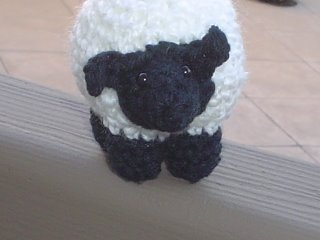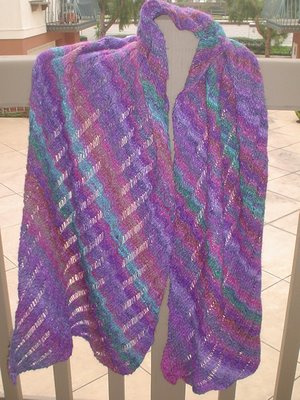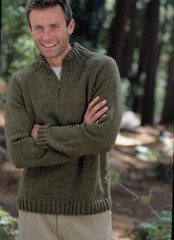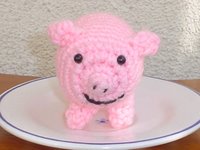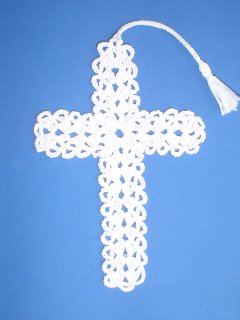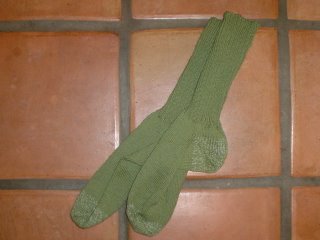
I will admit that I'm going to be resting on some of my knitting laurels until this amigurumi thing cools off a little. One aspect of knitting that I enjoy is finding the perfect recipe for a particular item, such as baby socks, or adult socks. I will knit an item over and over, making changes, taking bits from various patterns, seeking the ideal design. Here's a picture of a pair of socks that I'd call near perfect--yes, I was an English teacher once, and it would be more accurate to say nearly perfect, but it has a ring to it--Near Perfect Socks
These were for my stepdad, Paul, who is 6'3" and a wonderful person--though I think I should find more people to love who have smaller feet. My mother sneakily found out how long his feet are for me. I chose a khaki green from Lion Brand's Red Cross Kit, which is washable wool, 118 g, size 1 needles with a gauge of 8 stitches to the inch, and a working number of 80 stitches. I meant to make the WWII sock pattern, but found that I made so many changes, even though it is simple in appearance, that I can't call it that anymore. Even though I had a little yarn left, I was worried about running out, and at the same time I wanted to make the cuffs as long as possible, so I bought a good kitchen scale that weighs in both ounces and grams from Linens and Things. It has turned out to be useful for knitting several times since. I've yet to use it for cooking, though. After trying on many cast-ons, I prefer the invisible cast on from
Vogue Knitting: The Ultimate Knitting Book for top-down knitting of socks. But because of the concerns above, I did toe-up--one more English note: I was told in school never to start a sentence with but or because; do you know why? It's because you're more likely to write an incomplete sentence, that's all. Whew. My English teacher's conscience is really getting to me.
At any rate, the heel and toe are from Priscilla Gibson-Roberts wonderful book,
Simple Socks: Plain and Fancy. It took some practice, and my early experiments with baby socks definitely paid off:

These baby socks are not lying on my back pocket, but rather the outside of my denim purse.
The Nearly Perfect Sock ribbing is 2 X 2, which seems the stretchiest. I used reinforcement thread for the heel and toe, and I used her sewn cast-off, which is stretchy and professional looking. It took more than one attempt to bind off, because it was too tight at first. It needs a little stretching every few stitches to be sure it's just right.
Along the way I tried the Twisted Sisters (see The Twisted Sisters Sock Workbook: Dyeing, Painting, Spinning, Designing, Knitting) stretchy cast on, but found it nearly impossible for me to do with small needles. They have you cast on twice the number of stitches needed with simple loop cast on, then k2, P2 together. It's worked well for baby socks, but not here. They're also the ones who finally sold me on the hourglass, or peasant heel, because it's more easily repairable and elegant in design. It does make a good fitting heel. I needed even more help than the generous instructions they provided, though, and no one is as detailed as Ms. Gibson-Roberts.
Medical Question of the Month --How often do I need a physical?
Medical disclaimer--The following information is meant to give general information, not to treat individual cases. There may also be some variation in medical opinions about the following topic, but this information is up to date as of today. Also, I do not have an editor to help me with typo's or slips of the brain. If you have any questions or concerns, contact your doctor.
Answer--Not as often as you might think. Some recent studies have shown that physicals are not the health promotor that we once hoped they might be. We don't often find something wrong during a physical exam in someone without any complaints. Labs may turn up something in someone without any symptoms, but physicals have shown disappointing results. They're more for establishing a rapport with a physician, unless you have a medical condition or conditions that should be screened for. Here's a list of visits and why we do them:
Newborn--3 days and 2 weeks, make sure that all is going well, catch any early conditions before they cause a serious problem.
Babies--Every 2 months the first year of life. They need a lot of shots, and these are distributed along the visits. The doctor is looking at the baby's development and growth, again, to catch any early conditions so that they can be treated as soon as possible. This is to help children with medical problems to develop as normally as possible.
By the way, if children have a cold, they can still have their shots.
Toddlers--About every 6 months, depending on their need for shots.
Preschoolers--About every 2 years.
Schoolers--On an as needed basis.
Adolescence--Now we like to have an exam because of the new meningococcal vaccine and to update any other vaccines. Also, this is a good time to talk about adolescent development, and answer any questions the adolescent might have.
High School--If they didn't come in during adolescence. Schools will usually screen for scoliosis--a curvature of the spine that can grow worse and needs monitoring.
Adulthood--Please note that if anyone in your family had a cancer not caused by environmental toxins, you should be screened for the same thing starting about 10 years before their diagnosis age.
And I think every adult should have their blood pressure checked yearly, but you don't have to go to the doctor to do that.
18-35--If you're a guy, as needed. We all need a tetanus booster every 10 years, and now it's thought that pertussis needs the occasional boost, too. We should all have our cholesterol and fasting blood sugar checked at least every 5 years. People at risk for developing high cholesterol or diabetes should be screened more often--that usually means a family history of the same thing, or being overweight and/or sedentary.If you're a gal, you don't need a physical every year, but those who are sexually active, as we like to say these days, need to have a Pap smear done yearly. Those in a monogamous relationship (doctors usually mean "married" by this, as boyfriend-girlfriend or boy-boy or girl-girl relationships unmarried may say they're monogamous, but statistically are less likely to be than marrieds) and who have never been exposed to HPV, can have a Pap done every third year. That's a new guideline.
How about next time I explain more about HPV?
35 to 49? That depends on your family history and habits. Males develop heart disease before females; if you don't have any problems yet, your doctor may want to see you on the same schedule as before, to screen for diabetes and high cholesterol, and for general health counseling.
Women need to have a screening mammogram at age 40, then every 2 years. After 45, most doctors agree that a yearly mammogram is best. After menopause, women lose their edge with heart disease and need to get serious about screening, too. They also need calcium, 1500 mg plus a balance of vitamin D, and weight-bearing exercise. Perhaps a topic to go into more detail later.
Age 50 My idol in medical school, Dr. Templeton, would say, give yourself a colonoscopy for a birthday present at age 50, then don't worry about it for 10 years. Why should people die of colon cancer, the 4th most common here. In this country we don't have enough gastroenterologists to do all the colonoscopies needed, but it is a good goal. An alternative is to have fecal occult blood testing--some say yearly--and a flexible sigmoidoscopy every 5 years.
The National Guideline Clearinghouse has a summary of screening recommendations at their site.
My wish is that people would go to the doctor for overweight, and that people would not go for a simple cold, if you want to know the truth.
Where to find more medical information—There are several good books and Internet sites. One reputable source is from the American Academy of Family Physicians, called familydoctor.org.









